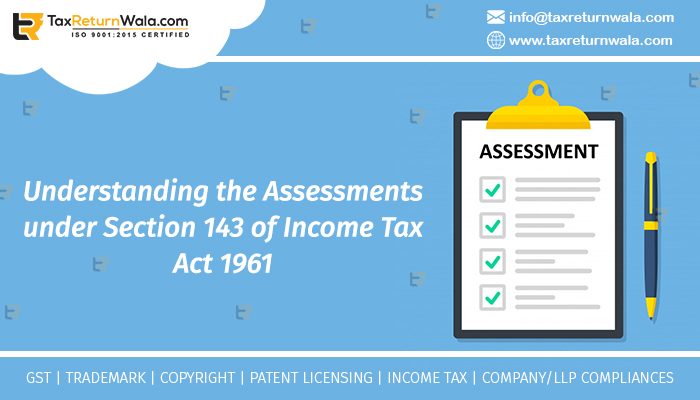Understanding the Assessments under Section 143 of Income Tax Act 1961
The government of India has made it mandatory for every individual of the country, who is earning an income, above a prescribed limit fixed by the authorities, to file for the Income Tax Return. The income tax return (popularly known as ITR) is basically a record where the individuals (taxpayers) provide structured information about their total annual earnings and incomes and tax liabilities and payments to the Income-tax department.
Every taxpayer has to show their financial records to the Income-tax authority of India. These records are furnished by filing his return of the earned income. As soon as the individual files his income tax return, the income tax department of India processes the information gathered. This step of evaluating is done to find the correctness of the records. Thus, this process where the income tax return is examined is known as Assessment.
Let us move ahead and get acquainted with the types of assessments under the Income-tax Act 1961. Under the Income-tax Law, there are four major assessments as given below:
- section 143(1), i.e., Summary assessment without calling the assessee i.e. taxpayer.
- Assessment under section 143(3), i.e., Scrutiny assessment.
- Assessment under section 144, i.e., Best judgment assessment.
- Assessment under section 147, i.e., Income escaping assessment.
Before moving further, it is important to comprehend the meaning of intimation and assessment as there is just a minute difference. An intimation is a financial record whereby the taxpayer is made known about the result of his computed annual income return and he is not mandated to further act upon it. Whereas, a notice is a legal record whereby the taxpayer has to necessarily act on it. This processing is done by the Central Board of Direct Taxes (CBDT) and the mode of communication is electronic, known as Centralized Communication Scheme (CCS).
Intimation u/s 143 (1)
A taxpayer will receive intimation under section 143(1) in the following circumstances:-
- If the assessee (taxpayer) has made more tax amount than he is liable to, and oughts to receive a refund from the Income-tax department…in this situation, the assessee receives an intimation with the refund amount specified on the intimation order. Here, the refund should be more than Rs.100, otherwise, the intimation order will not be executed.
- On contrary, if the assessee had paid less tax amount than he is liable to pay; then the income tax department will send an intimation notice to pay the specified tax amount.
The following adjustments are made to the total income in the return:
- Any arithmetical error in the return;
- An incorrect claim (provided the incorrect claim is apparent from the information filed);
- Disallowance of incorrectly claimed loss or expenditure;
- Any income which has not been included in the return
The result obtained after validating the incomes and tax amount are classified into three categories:-
- No Demand, No refund
In this type, there are some particular adjustments made which were mentioned in Intimation u/s 143(1). After the application of these adjustments, it results in no demand from the Income Tax Department nor does it owe any refund to the assessee.
- Demand determined
Here in this case, after making certain adjustments by the Income Tax Department it is seen that there needs to be some more additional payment of tax by the assessee. There can be a situation in which the assessee may agree, disagree or even decide for raising a revised Income Tax Return request.
- Refund determined
In this case, it is seen that there needs to be payment of some refund amount to the assessee. This amount can be sent to the assessee by the mailing address or be deposited into the bank account details of which were shared earlier.
Notice Under section 143(2)
The notice here is a record sent by the Income-tax department to the assessee when the return on the income tax filed by the assessee has been selected for scrutiny to evaluate the tax compliance. The department checks the following:
- If the incomes are undervalued.
- If the losses are claimed more than required.
- Underpayment of the income tax.
The assessing officer is supposed to service this notice within 6 months after the completion of the assessment year to which it pertains.
Need Tax Help?
Write to info@taxreturnwala.com


